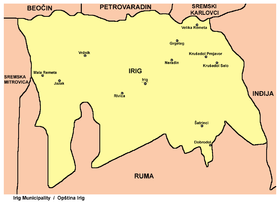Irig, Serbia
| Irig Ириг | ||
|---|---|---|
| Municipality and Town | ||
|
Serbian Orthodox church | ||
| ||
 Location of the municipality of Irig within Serbia | ||
| Coordinates: 45°06′N 19°51′E / 45.100°N 19.850°ECoordinates: 45°06′N 19°51′E / 45.100°N 19.850°E | ||
| Country | Serbia | |
| Province | Vojvodina | |
| District | Syrmia | |
| Settlements | 12 | |
| Government | ||
| • Mayor | Radovan Ercegovac | |
| Area[1] | ||
| • Municipality | 230 km2 (90 sq mi) | |
| Population (2011 census)[2] | ||
| • Town | 4,415 | |
| • Municipality | 10,866 | |
| Time zone | CET (UTC+1) | |
| • Summer (DST) | CEST (UTC+2) | |
| Postal code | 22406 | |
| Area code | +381 22 | |
| Car plates | RU | |
| Website |
www | |
Irig (Cyrillic: Ириг, pronounced [ǐriɡ]) is a town and municipality in the Syrmia District of Vojvodina, Serbia. The town has a population of 4,415, while Irig municipality has 10,866 inhabitants.
Name
In Serbian, the town is known as Irig (Ириг), in Croatian as Irig, in Hungarian as Ireg or Ürög, in German as Irick, in Slovak as Irig, and in Rusyn as Ириґ.
History
Irig was first mentioned in the historical documents in 1225. In the 15th century, the masters of the town were Serbian despots Vuk Grgurević, Đorđe Branković, and Jovan Branković. During the 15th and 16th century, ten Orthodox monasteries were built in the surrounding of Irig (Two of those were located just near the town).
Between 1526 and 1699, the town was under Ottoman administration. During this time, it belonged to the Sanjak of Syrmia, and was the administrative seat of one of the seven nahijas in that sanjak. In 1665, the town had 2,000 houses, one mosque and two monasteries. In this time, Irig was mostly inhabited by Muslim population.
Since 1699, Irig was part of the Habsburg Monarchy. In the 18th century, Irig was one of the most important market centers in Srem and most of its inhabitants were Serbs. In 1795-1796, the population of the town was decimated by plague. From the total population of 4,813 who lived in the town, 2,548 died of this disease.
In the late 19th and early 20th century, Irig was a district capital in the Syrmia County of the Kingdom of Croatia-Slavonia.
According to the 1900 census, the population of the Irig municipality numbered 22,313 inhabitants, of whom 16,893 were Orthodox Serbs, while the town of Irig itself had 5,196 inhabitants, of whom 3,936 were Orthodox Serbs.[3] According to the 1910 census, the population of the Irig municipality numbered 25,320 inhabitants, of whom 18,331 spoke Serbian, 3,552 Hungarian, 1,816 Croatian, and 1,031 German.[4]
Since 1918, Irig was part of the Kingdom of Serbs, Croats and Slovenes (later renamed to Kingdom of Yugoslavia) and subsequent South Slavic and Serb states. During World War II, 417 inhabitants of the town were executed by German fascists.
Inhabited places
Irig municipality includes the town of Irig and the following villages:
- Velika Remeta
- Vrdnik
- Grgeteg
- Dobrodol
- Jazak
- Krušedol Prnjavor
- Krušedol Selo
- Mala Remeta
- Neradin
- Rivica
- Šatrinci
Ethnic groups (2011 census)

The total population of the Irig municipality is 10,866, which includes:[5]
- Serbs = 8,534 (78.54%)
- Hungarians = 762 (7.01%)
- Croats = 232 (2.14%)
- Roma = 166 (1.53%)
- Others and undeclared = 1,172 (10.79%)
Most of the local communities are ethnically Serb, while two have a Hungarian majority: Šatrinci (Hungarian: Satrinca) and Dobrodol (Hungarian: Dobradópuszta).
Twin cities
See also
References
- ↑ "Municipalities of Serbia, 2006". Statistical Office of Serbia. Retrieved 2010-11-28.
- ↑ "2011 Census of Population, Households and Dwellings in the Republic of Serbia: Comparative Overview of the Number of Population in 1948, 1953, 1961, 1971, 1981, 1991, 2002 and 2011, Data by settlements" (PDF). Statistical Office of Republic Of Serbia, Belgrade. 2014. ISBN 978-86-6161-109-4. Retrieved 2014-06-27.
- ↑
- ↑
- ↑ "Population by ethnicity – Irig". Statistical Office of the Republic of Serbia (SORS). Retrieved 23 February 2013.
- Dr Željko Vučković - Stevan Pištević, Povesnica Kulturno-umetničkog društva "Zmaj" u Irigu 1905-2005, Irig, 2005.
- Ladislav Varga, Mozaik žitelja iriških, Novi Sad, 2001.




